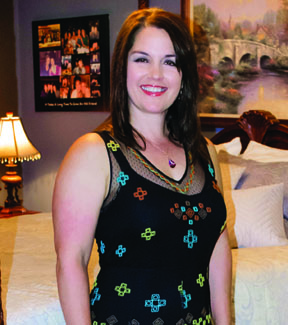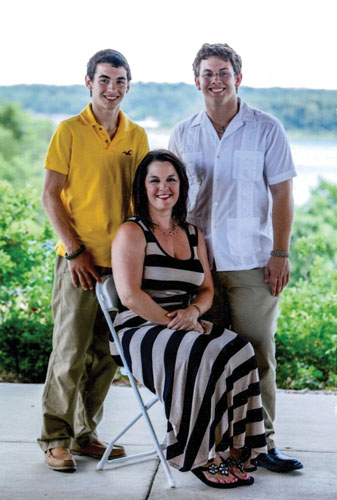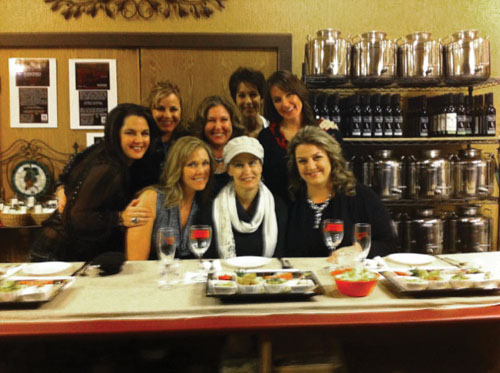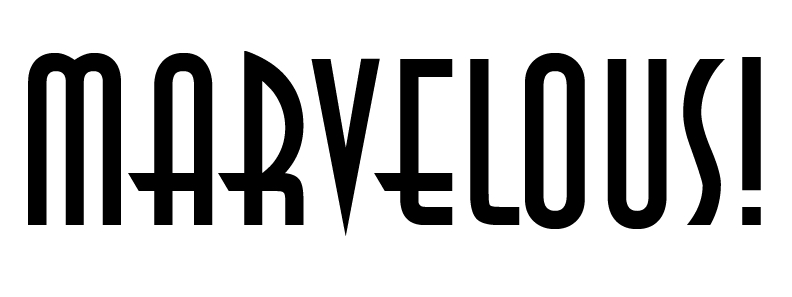
Article Brigitte Volltrauer-Shipman | Style Kelly Householder-Giuliano
Photography Deb Peterson and Courtesy of Brigitte Volltrauer-Shipman
One of my sisters once said to me, “You had a great ride.” She was right, I lived a charmed life until I became a mother, (which is still my greatest gift), and then, as they say, “life” happened. We are all eventually challenged on our journey through life, of course. Sometimes challenges happen early and plateau. Some of us are challenged in waves with time to rest in between. And some of us get hit over and over by tsunamis with just enough time to bob up and down for gasps of air. That’s what happened to me.

My journey began in Chicago. I was born into an extraordinary family, the daughter of German immigrants, and raised in a German culture with great love, loyalty and the mantra that family comes first. English is my second language. I could write a book (and maybe I will one day) about how I was taught to live with courage, strength, and defining perseverance while keeping my integrity intact. As with most first generation Americans, German is now my second language and English my first. My grandparents’ and parents’ culture is slowly fading with my generation, and although I can’t find the language to describe the respect I have for their way of life, I know that the values they instilled in me have been my lifeboat through the tsunamis.
My family moved to Bull Shoals when I was 12 years old. It was a huge transition for me going from a suburb of Chicago to a very small town in the South, but I soon found my way and have fond childhood memories. I found my love for sports while attending Flippin High School. I feel lucky to still have most of my best friends from my high school days in my life now.
After college, I married my high school sweetheart. We had lived away from home long enough, so we decided to return to our friends and families. Although we didn’t have jobs, we both felt in our hearts that it was time. I am pretty sure our parents lost a few nights of sleep over this decision, but we did not miss a beat. Charmed lives still.

And then I became pregnant with our first son and life got interesting. We had decided early that I would be a stay-at-home mom. We felt blessed that this became a reality. Our son, Joseph, was diagnosed with Pervasive Development Disorder (PDD) at age 3. This diagnosis is on the very tip of the high functioning end of the autistic spectrum. The autistic spectrum ranges from very high functioning to very low functioning abilities, which determines the prognosis of the quality of life predicted. Asperger’s Syndrome was just becoming a known diagnosis for children or adults with social awkward behavior and other developmental delays. Although Joseph was not diagnosed with Asperger’s, I felt he fit under that umbrella. My beautiful son, who demonstrated a million signs of genius, was now put into a very dark box.
The future seemed grim. Professionals said things like, “He might benefit from being enrolled in an institution,” or, “We’re not sure he will be able to attend kindergarten or be placed in mainstream education.” In public my son would get very upset, with limited expressive language, and I felt many people judged my parenting skills. I was advised at one point to read to him. This was amusing because I read to him every day and, in fact, Joseph could read well by age 3. To be fair, no one knew a whole lot about autism other than the reference to it in the movie Rain Man.
The battle to advocate for my son, my first tsunami, began. How can someone ever learn to be a contributing member of society without being part of it? We all learn the game of socialization by interacting with our peers. Social behavior can only be learned through experience with other humans in every social experience. I started helping other parents and kids in the autistic spectrum while helping my own son. I started a support group to share resources that I had found. I brought in guest speakers from connections I had made going to conferences on autism. I knew and believed knowledge is power, so as I learned and grew, so did my son. We were on this journey together. Every therapy that my son experienced was shared. There were many teachers who really wanted training on how to educate autistic students. In the late 90s, teachers were beginning to include autistic students in mainstream classrooms.
Through networking within the autistic community I made a friend who happened to be the president of our state autistic support group at the time. Anna Vollers was working full time supporting and educating the entire state of Arkansas. I invited Anna to Mountain Home to offer professional development for elementary teachers. The teachers’ interest was clear. The room was packed with teachers who wanted to educate and support children like my son. I was filled up with love from these wonderful, caring educators.
One of my most intimidating experiences as an advocate was standing in a semicircle of Harvard professors who were experts on sensory introduction. My husband and I were attending a conference at Harvard, where my brother-in-law was a student at the time. Dr. Michael J. Weiss introduced us to these professors, and it was my opportunity to plea for therapy software for children with sensory issues. We had come to realize that autistic children who lived in a rural setting had very limited resources. We had already spent a lot of our savings on therapy and travel.
Fast ForWard Sensory Integration, at the time, was offered only in certain cities, which meant added expense and time away from home. The therapy became available to us in Mountain Home six months later, and I used it with my son. Another great therapy we used was Berard Auditory Integration Training, known as AIT training. Using this therapy, I watched Joseph wake up and join us in our world.
Before I knew I wanted to become a life coach, I gave my phone number to doctors’ offices, schools, and community members, and worked with many families to find support for their children. This was a strong calling for me, and still is.
My son is a beautiful bright light that this world needs. He is a walking example of unconditional love. He is able to walk through life with the ability to remain joyful when most of us struggle with our tsunamis. He has the best one-liners that are profound and keep me grounded. His attitude is the one we are all searching for in life. We all have a light. Sometimes it shines very bright and other times it becomes dim. Joseph’s light is steadily bright.
When my second son, Jakob, was born, I bobbed up for air and continued to stay home with my children. I loved the privilege of staying home. Our second son was thriving and gifted. There were no signs of any disabilities. I continued advocating for Joseph, started a support group for parents of children in the autistic spectrum, continued as a group fitness trainer and personal trainer, and went back to school for my masters degree in leadership. I was busy, and I enjoyed family life. When Jakob started kindergarten, I decided to go back to teaching, and then the second tsunami hit. I became ill and was told I could die.
I was diagnosed with Type I diabetes, also known as juvenile diabetes. This is where your pancreas stops working altogether and you become dependent on insulin to stay alive. This affects all organs long-term and is a huge lifestyle change. I have to give myself shots to stay alive although I have a serious phobia of needles.

Kim McDonald, Helga Friedland, Kathy Arp, Kelley Nosari. They lost Katie to cancer on November 28, 2013, Thanksgiving Day.
I bobbed up for air again after this wave hit. While my life was changing, my career in education was also changing. I was a classroom teacher at Mountain Home Junior High teaching career orientation when the school reform called The Career Academy Program was being implemented with the leadership of Principal Dana Brown and then Career Academy Coordinator Susan Bergman at the high school. I felt my own passion emerge with the program, which offers students a pathway for finding their own passions through self discovery. That path originally began with a freshman class called Keystone. In Keystone, students take a semester class to develop a map of their high school years. Students end the semester able to articulate a 6-year educational plan, including the first two years of college. They map out what classes they are planning to take in pencil knowing they can change their map if their direction changes. The most important piece is that they understand the why of their high school design. Once their high school design is complete and they have committed to one of the three career academies, they have their parents sign off on the plan for one year. Students can adjust their academic design throughout their high school experience.
Once students enter one of the three career academies—Health and Human Services (HHS), Communication, Arts and Business (CAB), or Agriculture, Construction, Manufacturing and Engineering (ACME)—they stay committed to a one-year contract. Students can change their academy choice each year. This process is about self discovery and keeping the end in mind. The goal is to have every student leave Mountain Home High School Career Academies with a strong individual life design mapped out for their next steps after high school.
My role as the College and Career Coordinator for the Mountain Home Public School District is to facilitate all students through their transitions and individual educational design. Life transitions is my niche.
Life happens, and my third tsunami was about to hit, resulting in a great deal of grief. My life was about to change again, forever. (For many reasons, I am thinking this will be book number two!) My husband and I divorced, and he had a motorcycle accident which eventually took his life. Sometimes for no good reason tragedy strikes. The father of my children, a great man, had made choices that made his life challenging, and these hardships were passed on to me and our boys. He never recovered from his accident and began having seizures from the head injury he experienced. He did not have a helmet on when he lost control of the motorcycle. It’s very difficult to lose a parent at any age, but at 12 and 17 it is devastating.
I have not met a person who does not have a tragedy to share, but for many reasons we are shamed into keeping our stories hidden. Most societies teach us to share our stories with a hidden rubric. In other words, keep your expression of pain a secret. We are supposed to keep moving after a brief period of time. We are taught to put a smile on our face and get on with life. The fact is: grief is grief. There is no time limit on grief. Some of us heal faster than others. Some people get stuck in the grieving process. My family is still healing from our personal tragedy and holding each other up with love. Moving forward is a process, but we are doing it. That is why I am telling this story. I hope it will offer healing power to my family and me, and to others who are suffering.
Through loss I began searching for answers for how to get through life’s many challenges. I read several books and ran across articles written by Martha Beck in Oprah’s magazine, O. I became interested in Martha’s story and her career as a life coach. I knew I wanted to eventually enroll in her program, but as a single mom I also knew I needed to wait for another time in my life.
It took nearly a decade, but early last fall I enrolled in the Martha Beck life coaching program to become a life coach. The process of life coaching involves learning how to dissolve suffering, and it not only has given me life tools to live my best life, but also a tool box I can share with others. If I can make someone feel lighter with hope, then the life waves that have hit me, and will likely continue to hit, will all have been well worth it.

For those of you who are not clear on what life coaching is all about, I would compare it to having a personal fitness trainer but for life design. If you are in overall good health, but need someone to give you tools for discovering a balance between your essential self and social self, while answering your own “why” questions about life, then this philosophy of life coaching is for you. Your essential self is who you are at the core of your personality. Your social self is who you are taught to be. The social self keeps us in check with society and its rules. The essential self represents our true desires. The key is to be able to balance our social and essential selves to be both happy and productive. As life happens and you are in a place of change or any transition, whether it’s horrible or worse than you could have ever imagined, I can offer you life tools for redesigning your life.
Through all my life events, my tsunamis, I have found myself full of gratitude for my family and the group of women I call my tribe. Without my family and these incredible women, I am not sure I would have kept intact the pieces of me that were waiting to evolve into who I am today. There is a silence of understanding within my tribe. There is no need to ask if you need anything. The tribe knows and we are there for each other.
Surviving life’s traumas or tsunamis has taken me into a place of deep gratitude. It has shown me that you can’t truly appreciate tears of joy without tears of pain. The people who surround you and catch you when you’re plummeting to your lowest self, as my family and friends have done, are your earth angels. This is affirmation that the stars are aligning especially for you, and there is no need to try to explain it. Embrace your tsunamis and say thank you. That’s living life with deep gratitude. I will continue to hold tightly to my lifeboat of family values and live this life screaming “THANK YOU” each time I bob up for air. M! August/September 2016

Leave a Reply